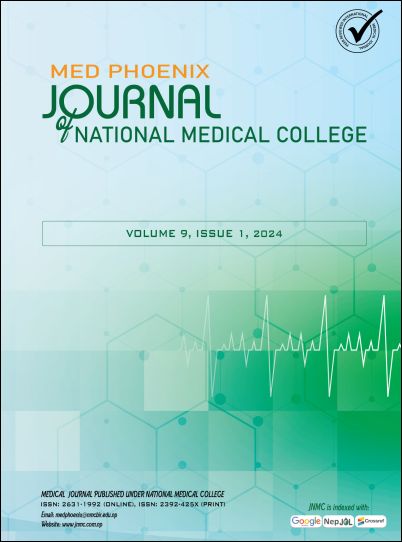Spot Urine Protein Creatinine Ratio in Comparison to 24-Hour Urinary Protein for Detection of Proteinuria in Type 2 Diabetic Patients
DOI:
https://doi.org/10.3126/medphoenix.v9i1.67181Keywords:
Diabetic Nephropathy, Proteinuria, Protein Creatinine Ratio, SensitivityAbstract
Introduction: Diabetic nephropathy is a disease in which both glucose and protein appears in urine and is characterized by progressive renal damage due to the long-term hyperglycemia affecting the glomerulus and ultimately degrading the filtrating ability of the kidney. Determination of 24-hour urine protein excretion is simple and inoffensive method and is considered to be a gold-standard one. The method is time consuming, tiresome, and imprecise due to collection error. Random urine sample for protein creatinine ratio (PCR) would be more acceptable and less time consuming. Therefore, the present study was carried to compare the efficacy of spot urinary PCR with the 24-hour urinary protein in type 2 diabetic patients.
Materials and Methods: A hospital based cross-sectional study was conducted and total of 66 participants were recruited from department of internal medicine, Star Hospital, Lalitpur, Nepal. Urine samples were analyzed for protein and creatinine by pyrogallol red method and modified Jaffe’s reaction. 24-hour urinary protein (24 HUP) was used as a goldstandard method and was compared with spot PCR.
Results: The finding from study depicts strong correlation between spot protein creatinine ratio and 24-hour urinary protein (r=0.63, p= 0.001). A PCR <0.37 ruled out significant proteinuria (>300mg/day) with sensitivity and specificity of 84.4% and 100%, respectively. Similarly, PCR value at cut off of 0.9 had sensitivity (86%) and specificity (71%) for detection of severe proteinuria (>5000mg/day).
Conclusion: A strong correlation between spot PCR and 24-hour urine protein was obtained. The present study suggests that random urine PCR can be reasonable alternative to predict the amount of 24-hour urine protein excretion with high accuracy.
Downloads
Downloads
Published
How to Cite
Issue
Section
License
Copyright (c) 2024 Med Phoenix

This work is licensed under a Creative Commons Attribution-NonCommercial 4.0 International License.
This license enables reusers to distribute, remix, adapt, and build upon the material in any medium or format, so long as attribution is given to the creator.
Copyright on any research article is transferred in full to MED PHOENIX upon publication. The copyright transfer includes the right to reproduce and distribute the article in any form of reproduction (printing, electronic media or any other form).




